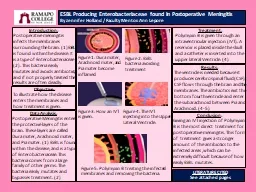

found in Postoperative Meningitis By Jennifer Holland Faculty Mentor Ann Lepore Introduction Postoperative meningitis infects the membranes surrounding the brain 1 ESBL is found within the disease It is a type of ID: 933282
Download Presentation The PPT/PDF document "ESBL Producing Enterobacteriaceae" is the property of its rightful owner. Permission is granted to download and print the materials on this web site for personal, non-commercial use only, and to display it on your personal computer provided you do not modify the materials and that you retain all copyright notices contained in the materials. By downloading content from our website, you accept the terms of this agreement.
Slide1
ESBL Producing
Enterobacteriaceae found in Postoperative MeningitisBy Jennifer Holland / Faculty Mentor: Ann Lepore
Introduction:
Postoperative meningitis infects the membranes surrounding the brain. (1) ESBL is found within the disease. It is a type of Enterobacteriaceae (2). This bacteria easily mutates and avoids antibiotics, and if not properly treated the results are often deadly.
Objective:
To
illustrate how the disease enters the membranes and how treatment is given.
Figure 1: Dura mater,
Arachnoid
mater, and
P
ia
mater become inflamed
Figure 2: ESBL bacteria avoiding treatment
Figure 3: How an IVT is given.
Figure 4: The IVT injecting into the Upper Lateral Ventricle.
Figure 5: Polymyxin B treating the infected membranes and removing the bacteria.
Data Analysis:
Postoperative Meningitis enters the protective layers of the brain. These layers are called Dura mater,
Arachnoid
mater, and Pia mater. (1) ESBL is found within the disease, and is a type of Enterobacteriaceae. This bacteria comes from a large family of other germs. The bacteria easily mutates and bypasses treatment. (2)
Treatment: Polymyxin B is given through an intraventricular injection (IVT). A reservoir is placed inside the skull and a catheter is inserted into the upper lateral Ventricle. (4)
Results: The ventricle is needed because it produces cerebrospinal fluid (CSF).CSF flows through the brain and the membranes. The antibiotics exit the bottom fourth ventricle and enter the subarachnoid between Pia and Arachnoid. (4-5)
LITERATURE CITEDSee attached pages
Conclusion:
Giving an IVT injection of
Polymyxin
B is the most direct treatment for postoperative meningitis. This form of treatment gives a stronger amount of the antibiotics to the infected areas
,
which can be extremely difficult because of how easily ESBL mutates.
Slide2Works Cited
Shamim, Muhammad Shahzad, et al. “Intrathecal and Intraventricular Antibiotics for
Postoperative Gram-Negative Meningitis and Ventriculitis.” Surgical Neurology International
, 26 Sept. 2017, doi:10.4103/sni.sni_81_17. Zheng, Guanghui, et al. “Phenotype, Molecular Characterisation and Risk Factors for
Postoperative Meningitis Caused by ESBL-Producing-Enterobacteriaceae: A Six
Years Multi-Centre Comparative Cohort Study.” BMC Infectious Diseases, 19 Jan. 2021,
doi:10.1186/s12879-021-05784-7.